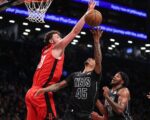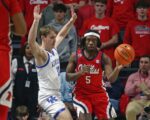The following story contains spoilers for Season 1 of Kaleidoscope.
Back in 2012, when the United States east coast was devastated by Hurricane Sandy, one of many locations hit particularly hard was Wall Street. And while there was physical and structural damage just about everywhere the storm hit, Wall Street felt the damage elsewhere: in its wallet. That’s because it was reported that 1.3 million bond and stock certificates—worth somewhere in the range of $70 billion—were flooded in an underground vault as a result of Sandy. That money, it would seem, was gone.
While 99.9% of the bonds were ultimately recovered within six months of the flooding, the ‘what if’ of the story turned out to inspire Netflix’s first big series of 2023. This true story proved to be the genesis for the heist at the core of the innovative new heist thriller series, Kaleidoscope. “That’s a perfect cover-up for a heist,” creator Eric Garcia told Netflix’s Tudum. “If I’m doing a heist, I’m going to use Hurricane Sandy as my excuse.”
So what are the bonds in Kaleidoscope, anyway?

Just like with basically anything pertaining to finance and/or currency, you can do a real deep dive on bearer bonds, why they’re issued, and what they’re all about. But that can get pretty inside baseball, so we’ll keep it simple here: for the purpose of Kaleidoscope, you essentially just need to know that bearer bonds are a type of currency that is fixed in value (meaning their price will never change on the whims of any sort of market) and isn’t registered, officially, anywhere or to anyone.
That means whoever holds the physical bonds is the owner of the currency and makes them a good and untraceable target for—say—a heist.
“They can be used as cash to buy anything from stolen jewels to stolen art. If they’re unmarked, they can’t be traced. If you have them in your possession, they are yours,” Kaleidoscope star Giancarlo Esposito, who plays Leo/Ray, told Tudum.
In the United States, bonds were historically issued as a sort of pay-it-forward investment at times when the country was short on resources. In a memorable bit of historical fiction, in Captain America: The First Avenger, the U.S. Government uses Steve Rogers as “Captain America” as a piece of propaganda to sell War Bonds to aid their efforts in World War II. In theory, people would give money to help in the moment and get the “bonds” that would pay out with interest at a later time.
And who, exactly, are the Triplets?
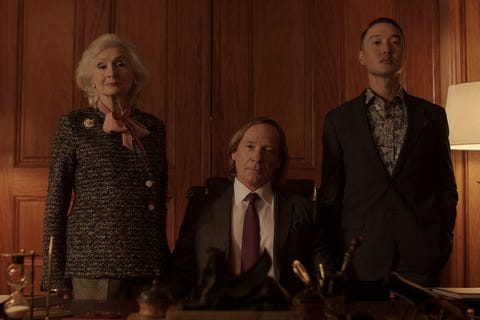
The most powerful group of people depicted in Kaleidoscope is a trio called “The Triplets,” who not only control the $7 billion in bearer bonds that serve as the object of interest for both Roger’s company/impenetrable vault and Leo/Ray’s heist but who also are depicted as and said to be people who are extremely dangerous. They are Cho-young-woo, Suzanne Grosvenor, and Stefan Thiele; the show opens—assuming you begin with “Yellow”—with Hannah Kim (Leo/Ray’s daughter, but working and functioning as Roger’s right-hand woman) proving to Thiele that their company, SLS, is adept and secure enough to handle their $7 billion in bonds.
On numerous occasions during the show, characters essentially say they don’t want to get involved with The Triplets, with the fear being that they come from a position of a lot of power—and could retaliate without any kind of consequence.
OK, OK. Got it. So what happened to the bonds at the end of Kaleidoscope?
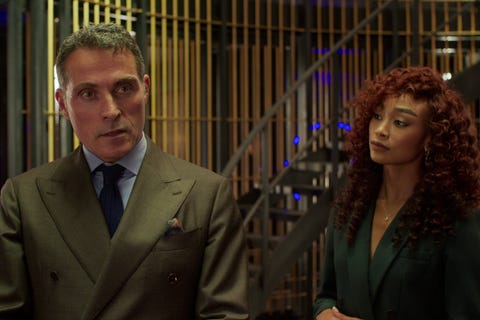
It probably seems like some really complicated switcheroos went down at the end of Kaleidoscope, as explained in the tail end of the episode “White” (while the first 7 episodes can be watched in any order, it’s suggested that viewers finish up with “White”). But it’s not as complicated as you might think.
At the end of the day, everything that Leo/Ray’s crew planned was successful. Well, as far as the heist aspect goes—RJ still died, Bob got left for dead and ultimately lost his voice, and Ava got shot on her way out of the building, among other hiccups—but as far as bees getting in the way of the gait detector, flooding the vault, and framing Roger for the theft of a priceless ruby years earlier, everything went according to plan.
The one unexpected thing that happened aspect of things was that Leo/Ray’s inside man—his daughter, Hannah, whom he’d thought was on his side as Roger’s most trusted lieutenant—was actually running her own scheme. Hannah, with the help of her sister Liz, actually switched out the vast majority of the bonds with similarly-weighted construction paper; Ray/Leo’s crew thought they were successful, but Hannah was collecting the bonds herself to sell them back to the triplets.
It was said throughout the series how dangerous The Triplets were, and this insistence was not lost on Hannah. Instead of allowing her father to run this dangerous heist—and likely lose his life if/when The Triplets found out—she teamed up with them to allow them to, essentially, double their money up. They wanted to “clean” (aka launder) their money all along, and by staging a heist, they were able to recoup the same money via insurance payouts. But since Hannah also returned the bonds to them, this rich and powerful trio wound up doubling up.
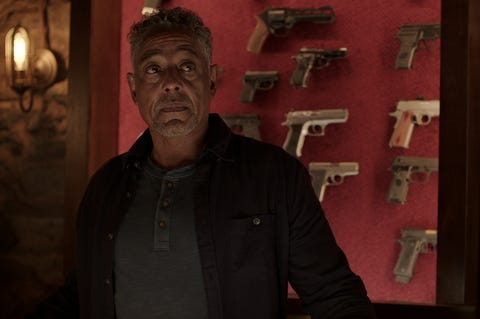
The show reflects a reality where the powerful win and the little guy just has to take it and accept the crumbs. “The rich get richer, and we get to live,” Hannah tells her father. Clearly, Hannah cut a deal with The Triplets to also leave her father out of it and allow him to complete his plan of framing Roger.
But in the episode “Pink,” we also see that Hannah’s fear of The Triplets was not unfounded; Agent Abbasi (a horrible person who called ICE on Ava’s childhood nanny and friend) was still poking around and asking questions about them, and after an interaction with an old man, she was likely poisoned and dropped dead in the middle of the street. Rough!
We can also see in the episode “Pink” that Hannah’s work with The Triplets likely didn’t go without reward; when she has her reunion FaceTime with Leo/Ray, she’s living comfortably in quite a lavish home. If she was even rewarded a 1% commission on helping The Triplets clean/launder/double their $7 billion, she would’ve come away with $70 million. Not too shabby a nest egg. If Kaleidoscope continues its story in a Season 2, we’ll see how far that money goes—and if any other hiccups manifest along the way.


Evan is the culture editor for Men’s Health, with bylines in The New York Times, MTV News, Brooklyn Magazine, and VICE. He loves weird movies, watches too much TV, and listens to music more often than he doesn’t.





